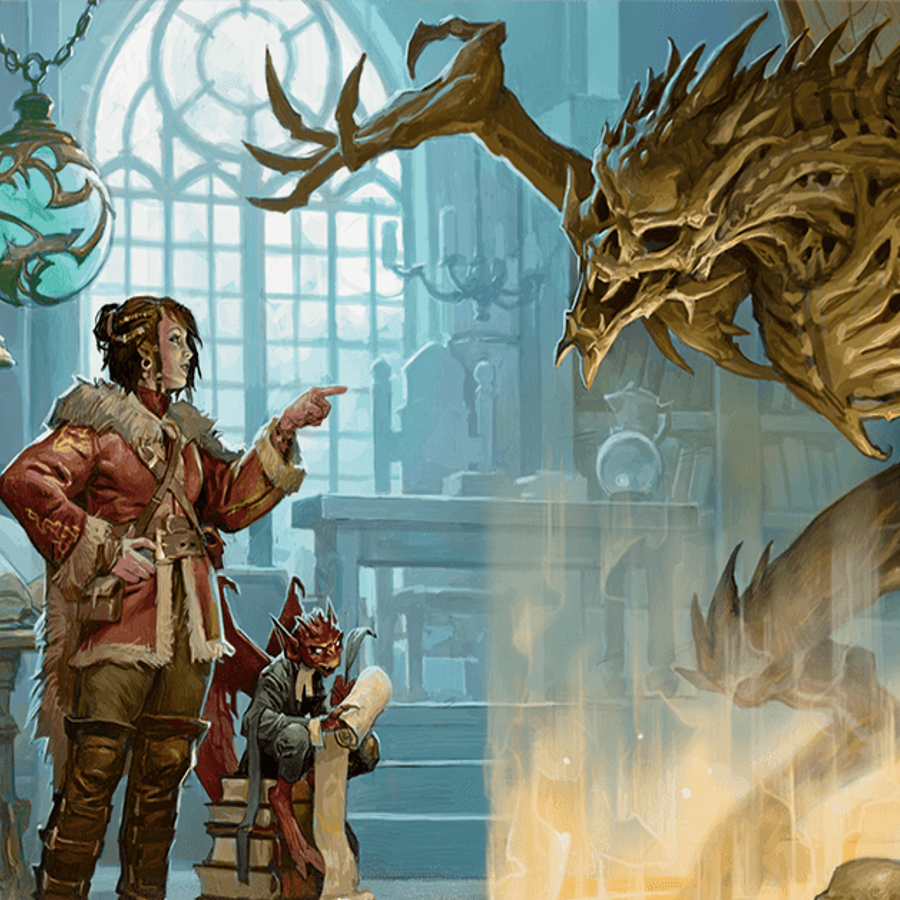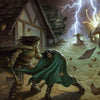Don't Neglect These 5 Crucial Game Master Duties

Written by Luke Hart
Imagine a D&D game with no rules. Or worse yet, imagine a dead game that has rules no one can agree upon, where each player uses them to their own best advantage without considering other players’ interests, and it simply devolves into an arguing contest.
Can you imagine spending four hours of your life at the gaming table where you’re supposed to be having fun, but instead, everyone is just arguing? The sad part about this is that I’m sure many of us have been there. You know exactly what I’m talking about. It is not a happy time.
People complain all the time about their gaming groups not sticking together and fizzling out. Well, I can tell you one thing for sure. If you ever have a gaming group that is pretty much just nonstop arguing, that group will implode sooner rather than later.
This is one reason why the game master’s role as the arbiter is so very critical.
Today, I’ll go over the game master’s five crucial responsibilities in the role of arbiter. A few weeks ago, I wrote about the seven primary roles of a game master, one of which is that of the arbiter. So, let’s dive deep into the arbiter role because if you neglect your responsibilities as the arbiter, your game will greatly suffer, and most likely, so will you.
What does it mean to be an arbiter?
The act of being the arbiter in a tabletop role-playing game like D&D is sometimes referred to as judging or refereeing the game. Essentially, you are officiating the rules during play. Although players can help with this to a certain degree, it is the game master’s primary role. Furthermore, even though players might help look up rules in the books—because many of these games we play have tons of rules, don’t they?—how to enforce or interpret a rule is always the game master’s final decision.
The essence of being an arbiter is that when a player tells the game master what they want to do, the game master uses the rules and their own judgment to determine what happens. Many times, this involves asking the player to roll the dice, and then, based upon the result, the game master determines the player character’s actions.
So this is pretty basic, pretty simple, right? However, there are 5 crucial things that a game master must do to properly execute the rule as arbiter.
Watch or listen to this article by clicking the video below.
#1 Learn the Rules
Look, I don’t care how long you have been running a game system like D&D or Pathfinder; you’ll probably never learn all the rules and certainly not have them all memorized. It is extremely rare for a GM to know every game rule every time. Even when we look at so-called rules-light tabletop RPGs, they still tend to have lots of rules.
One of my current favorite lightweight tabletop RPGs is Shadow Dark. This bad boy is still over 300 pages long. Now, yes, you can probably sum up the core rules of how to run the game in about 30 pages or so, but several ancillary rules will come up from time to time that you’re just not going to have memorized.
Overall, I recommend that a game master learn the basic concepts of the rules instead of trying to learn every rule in the books. In almost any game system, you’ll find that 80% of the game is played with about 20% of the rules, and the rest will come up sporadically during play. So, you want to focus on learning the 20% you’ll need on a continual and frequent basis. Then, when the other 80% of the rules come up, you can either look them up in the book quickly or just make a house ruling to keep things moving.
But beyond just knowing the letter of the law, so to speak, the game master needs to understand the intent, the spirit, of the rules. When I’m running D&D or Pathfinder 2, I’ll often find rules that I’m pretty sure the game designers intended to mean one thing, even though the rules seem to indicate another. Understanding that spirit or intent is important to being able to adjudicate and officiate. You see, this helps you a lot when settling an argument or discussion with a player. I will often use that line of defense as well. I will say that even though the rule seems to say X, that was not the spirit or the intent of the rule, and therefore, I am going to rule Y.
The bottom line is that you cannot be an arbiter if you don’t understand the core rules and their underlying principles. Technically, you can be an arbiter even if you don’t know the rules, but this would be akin to me being a soccer referee. My knowledge of soccer rules is very bad. I know you have to kick the ball down the field and get it in the net. That’s about it. If a player lowers their shoulder and knocks another over, I’m going to say that’s OK because when I played football, we did that all the time.
So, what is the best way to learn the rules? First, you should probably start by reading the rule books, right? That’s always a good place to start, although I’ll wager a guess that some game masters don’t even do that. If they don’t, their players are very likely to notice. Just don’t be that game master.
Some of these rulebooks are massive, so I’ll give you an idea about which rules are the most important to help guide your learning. Generally speaking, the rules for combat and skill come up the most during games. For instance, if you look at your average D&D or Pathfinder 2 game, you’ll spend 50% or more of your game time in combat. So, you should probably know those rules. You’ll spend the other 40% of the game in social interactions and exploration scenes. During those moments, the players will mostly use skills like Investigation, Perception, Diplomacy, or Intimidation.
If you want to use a shortcut, focus on the combat and skill rules, and you’ll learn most of the rules used in-game—at least, from the game master’s view. Now, of course, there are a whole bunch of character-creation rules and feats. But ultimately, your players should know those rules because they pertain to their characters, but it definitely behooves the game master to know them, too.
I’m a player in a Pathfinder 2 game right now, and one of the main reasons I joined that game as a player is so to learn the character and player side of the rules. I think there’s no better way to learn something than by doing it.
While you’re learning the rules, look for commonalities. For instance, in D&D 5th edition, the most prominent rule is the advantage and disadvantage mechanic. Much of the game is built around that mechanic, so the GM should remember that and file it back in their brain with the expectation that much of the time, the answer to any sort of modifier question will be advantage or disadvantage. Pathfinder 2, however, focuses on smaller +1 or +2 static bonuses with limitations on how bonuses can stack.
This is an example of how understanding the game’s underlying mechanics helps the game master make better decisions when the rules are unknown or unclear.
Part of learning the rules is striving to know them better as time goes on. I also suggest reviewing the rules you use often and exploring the less-used ones as well, especially before a game session. For instance, in my Pathfinder 2 games, I still struggle to understand the rules around perception because they’re fairly complex. So, before a game, I often turn to the rule section on perception, obscurement, and detecting creatures to brush up on them. I literally have that section bookmarked, so I can find it easily.
When I’m going to have a game session that features less commonly used rules, I’ll also brush up on them. For instance, the rules on swimming or drowning don’t come up a whole lot, but if I know my next game session will involve underwater exploration, I might want to take a peek at those, right?
#2 Adjudicating the Rules
Once the game master knows the rules or at least understands the core mechanics, adjudication just comes down to ensuring that everyone follows the rules and that they are the same for everyone.
The game’s central mechanics should rarely be ignored. In other words, you should follow them almost all of the time. This ensures that the game remains properly balanced and makes sense.
However, you can ignore the rules in exchange for fun. This is often known as the rule of cool. But you should only make those exceptions knowingly and intentionally and still hold to the intent or spirit of the rules even when you’re not adhering to them as written.
For example, in D&D, you may choose to give someone an advantage to support a cool moment, even if that advantage would normally be canceled by the disadvantage they are currently experiencing.
Or, you might allow a player to make a rule to jump farther than the rules would normally allow them if they come up with a good reason. However, the distance they can jump should not be outside the realms of reason. For instance, if a cleric with no athletic ability who wears full plate armor wants to make a 25-foot jump, that’s just not going to be possible unless, of course, they are propelled forward by the breath of a red dragon breathing on their bum. Then, possibly, I could see that happening, though they’re likely to take 12d6 fire damage as well!
And here is a very important point. The game master should not make exceptions for some players but not do so for other players, especially when considering the same rules. If you always give Sally advantage when she shouldn’t have it, but Timmy never gets the same treatment, well, that’s favoritism. Behaviors like that are the sort that cause bitterness, infighting, and games falling apart.
Making rulings. The game master is called upon to make rulings in a variety of situations, either because the rule doesn’t exist or the group doesn’t know the rule offhand, and pausing the game to look it up would break the momentum of a dramatic moment or negatively impact pacing. Here is what I suggest for moments when the game master has to make a ruling.
First, it cannot be understated that sometimes you just need to do your best and make a quick ruling rather than spending 20 minutes pouring through the books during a game session or looking up discussions on Reddit because a rule has a great deal of gray area to it.
When you’re making these quick rulings, understanding the underlying game’s principles and mechanics makes it far easier to make good rulings and judgment calls. If you never bothered to learn the core game mechanics of your game system, then the chances of you making a good ruling in the moment are very bad.
When making an off-the-cuff game master ruling, you should do your best to adhere to the basic concepts of the rules as much as possible. For instance, if you’re playing D&D, as the game master, you’ll probably award either advantage or disadvantage in your game when a gray area comes up. But, if you’re playing Pathfinder 2, you’ll want to give a + 1 circumstance bonus or -1 circumstance penalty.
Finally, if you don’t know a rule but have to make a call during a game session, you should look it up after the game session to learn how it was intended to be run. During a game session, I will often tell my players that I will make a quick ruling so we can keep moving and playing the game but that I will look into it after the game is over and get back to them, probably through e-mail.
Another thing we often do is I will make a quick ruling, and we’ll continue playing the game. While doing that, another player who isn’t doing anything will look up the rule online or in the books. About 10 minutes later, we’ll come back to that player and find out what they discovered. This probably won’t impact the ruling, but it will help inform us in the future.
#3 Determine Limitations
As the arbiter, you’ll also need to determine limitations. This falls into two basic categories. The first is the limitation of the rules’ intent, and the second is the limitation of the rules’ options.
When we talk about the limitation of the rules’ intent, what we mean is understanding why the rules were written as they were, why they exist, and the limits to those rules.
For example, in a game system where a natural 20 always succeeds, the basic laws of physics in the game world should still apply. Someone may be able to jump a 25-foot chasm on a natural 20, but they’re not going to jump to the moon or even across a 50-foot ravine.
If you want to run an easier or harder game, understanding how the rules work and adjusting them appropriately is essential.
For example, in Pathfinder 2, a hero point can stop a character from dying, and the characters get a free hero point every game session. If you want to make the game deadlier, eliminating the free hero point every session will do that. However, the game master should then try to award hero points so the core mechanic still has value. Pathfinder 2 is a deadly game as it is, and hero points exist for a reason. Eliminating them entirely is something the game master should discuss with the players before making such a huge change.
The second type of limitation, that of limiting rule options, applies when customizing a campaign or adventure along a specific theme.
For instance, I’m running Escape from the Fey for my ancient dragon patrons, a continuation of my Into the Fey adventure module. For Escape from the Fey, I told my players that none of their characters are allowed to be from the Fey Plane because the entire campaign revolves around the idea that the characters are trapped on the Fey Plane and trying to find their way home. So, if they’re from the Fey Plane, the entire campaign premise pretty much falls apart.
However, it is important to note that these limitations should never be arbitrary. Whenever you impose a limitation on your characters or gameplay, it should be for a very specific purpose.
For example, let us suppose you hate animal races because you think they break the seriousness of the game. Should you then ban races like tabaxi or catfolk? It’s not completely arbitrary, per se, but it’s not the best of reasons either, in my opinion. I think it would be far better to simply explain to your players the tone you’re trying to achieve and ask them if they’d mind not including those sorts of characters. This is far better than just saying no.
However, that said, there are times when no is the answer. For example, several races in D&D 5th edition can fly at first level. However, the last I knew, D&D’s Adventures League banned those races explicitly because they could fly. You see, they understand that flying at first level is a major game-breaking ability in many situations.
And yet, in most situations, the “no” should come with a “but.”
For example, if a player declares they wish to convince the king to make them a noble in charge of their entire household, the game master may decide that that isn’t even possible. It is simply outside the scope of what a character can do with their Diplomacy skills. However, the game master might respond that if the characters were to go on a mission of great value to the king, a minor noble title might be on the table—if they return successful, of course. If they fail, they should probably never show their faces around there again.
You see, this results in the game master setting limitations but also giving the players a mechanism for achieving some of what they were looking for in the game. And you’re doing it through a reasonable means that makes for a new adventure hook that furthers gameplay.
#4 Teaching the Rules
Ah, yes, you thought it was bad enough that you had to learn all the rules. Well, guess what? You get to teach the rules as well.
A game master may need to become a teacher of the rules for several reasons: you have new players; you’re generating new characters, which can be complex in many systems; you’re introducing new rules to an established system; you’re changing to a new addition; or you have players who are used to playing under another game master who had established different house rules.
I was a teacher for four years, and I can tell you that teaching is an art. The core of the art of teaching rules is knowing what they are, recognizing where they are confusing or contradictory, and understanding how each player learns.
For some players, a verbal explanation may be enough. Others do better with a practical demonstration like a sample combat. Yet others learn better through the written word, such as showing them the rules in the book and talking them through the text.
Now, not everyone is a teacher, and by the way, did you know that about 44% of teachers quit within the first five years? Even those of us who do choose that profession and gain the necessary education to do so still give up at an alarming rate. Of course, as a former teacher and someone who’s also done a lot of volunteering in a variety of schools, I can tell you that there are probably two main reasons most teachers quit. However, we’re not going to talk about that today because folks might get upsetti spaghetti over that topic, and it has nothing to do with the D&D anyway, does it?
Anyway, as I was saying, not everyone is a teacher. And if you think this is a weakness of yours, there are tons of good resources online and many great YouTube channels that specifically teach the rules of the game.
For instance, if you’re playing Pathfinder or D&D, the “How It’s Played” YouTube channel has videos that are like WikiHow videos for specific rule sets within the game.
For Traveller and Call of Cthulu, Seth Skorkowsky has an entire series about the rules, their intent, and how to play them. Most major gaming companies probably have their own YouTube channels with videos that walk through how to get started and the rules in general.
#5 Drawing a Hard Line
The final thing to remember is this: at the end of the day, the game master is the arbiter. What the game master says goes.
Now, I firmly believe that players should be allowed to make their case—by citing rules within the intent and the spirit of the game to help support those cases, of course—but the word of the game master, at the end of the day, is law.
I always let my players state their side before I make my final decision. However, that final decision is mine.
The bottom line is that the game master should not allow the game to grind to a halt because a player wants to argue about a rule. The GM needs to make a call, and the game needs to move on.
Quite frankly, if you find yourself with a player who always wants to argue about the rules, and this is causing your entire game to grind through a halt time and time again, ruining the fun atmosphere at the game table—well, this is one of the types of problem players you’ll need to deal with. Sometimes, if they’re unwilling to let things go and let you fulfill your role as the arbiter, the best thing may be to remove them from the game. Look, no one wants to spend three out of four hours arguing about rules. That is never fun.
You see, the time for those sorts of discussions is after or between game sessions, not during.
A 5e Adventure Module Filled with Fey Creatures and Their Tricksy Plots!
If you’re looking to start up a new 5e campaign or reboot your current one, Into the Fey may be exactly what you need. Designed for levels 1 to 5, Into the Fey contains everything you need to start playing:
- 11 fey-themed adventures
- over 40 new fey creatures
- the fully fleshed-out starting town of Aeredale
- regional information and maps for both the material and fey planes
Pick up the Into the Fey Ultimate Bundle to get the hardcover, the PDF, digital maps, and digital tokens.
Starting a new campaign can be tons of work; let Into the Fey do some of the heavy lifting for you!
-
Posted in
Game Master How-To Articles







